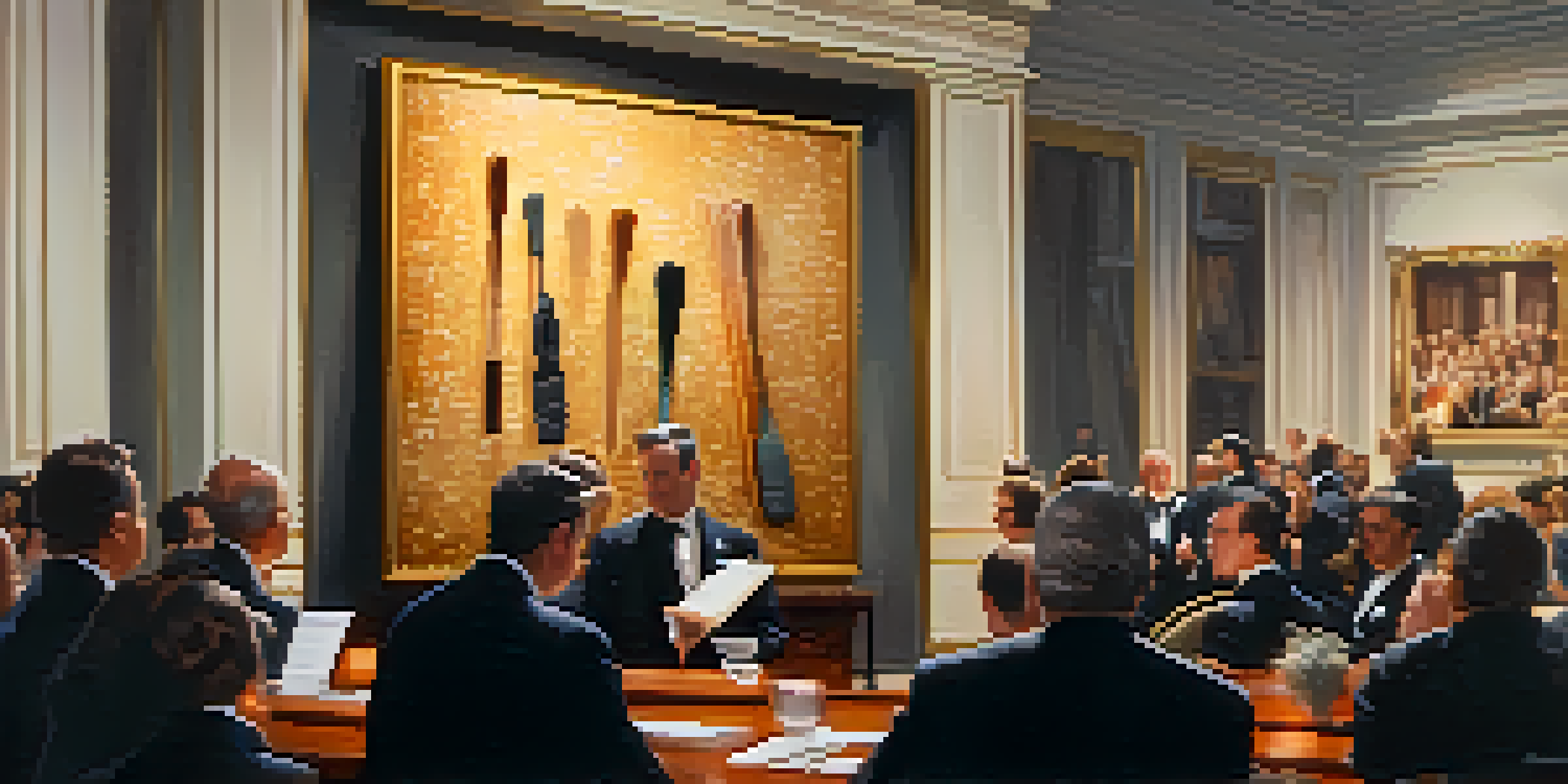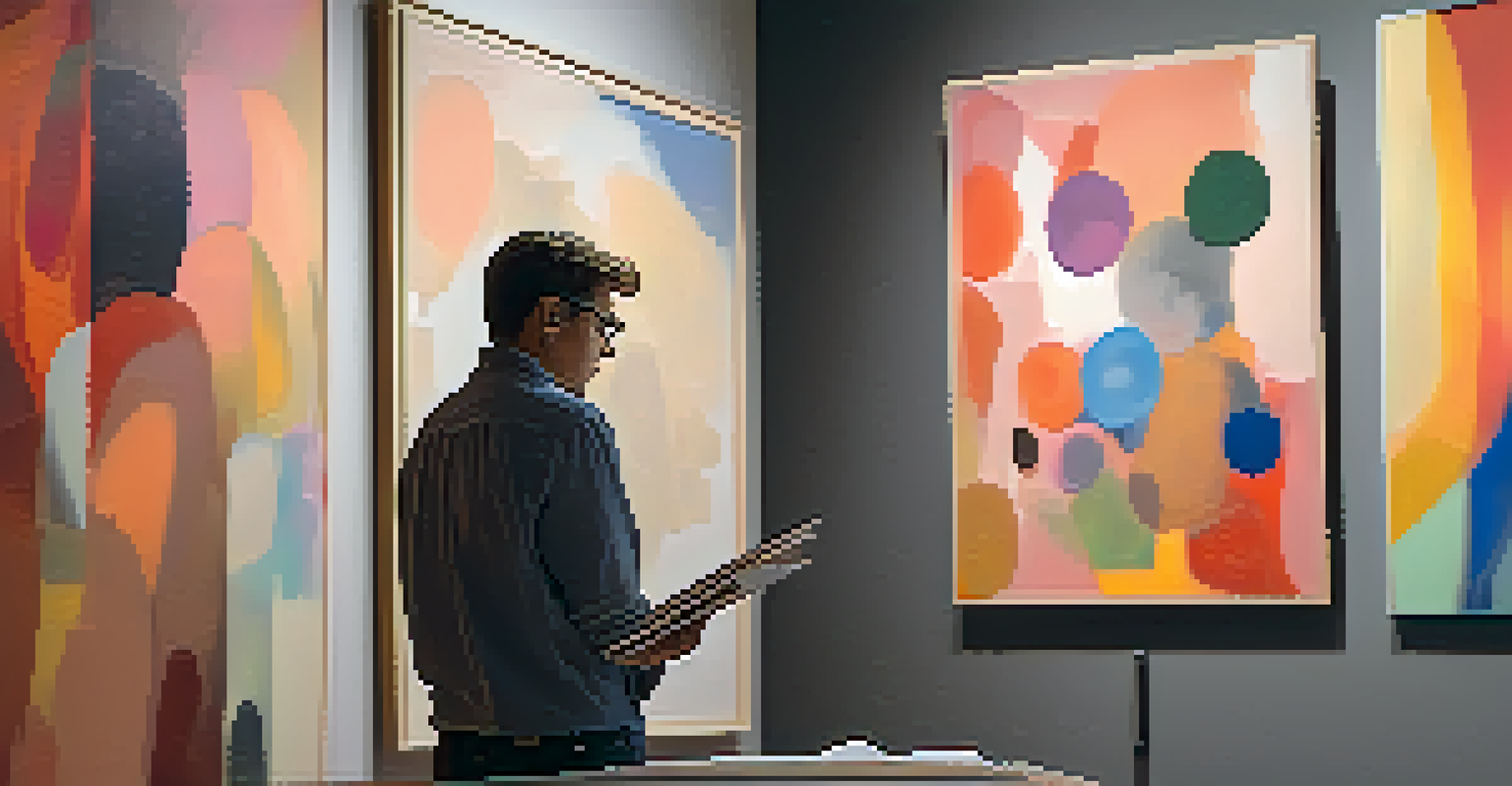Investing in Art: Financial Benefits of Collecting

Understanding Art as an Investment Vehicle
Investing in art might seem niche, but it's a growing avenue that savvy collectors are embracing. Just like stocks or real estate, art can appreciate in value over time, offering a unique investment opportunity. The key lies in understanding the market, the artists, and the potential for future value.
Investing in art is not just about financial returns; it's about the emotional and aesthetic value it brings into our lives.
Art has a tangible quality that makes it different from more traditional investments. It can beautify your space while simultaneously growing in value, making it an appealing dual-purpose asset. This blend of aesthetics and financial gain is what attracts many to the art world.
Moreover, the global art market has shown consistent growth, with top-tier pieces fetching millions at auctions. As more people recognize art's potential, the demand for quality works continues to rise, making it a compelling investment option.
Diversification: Balancing Your Investment Portfolio
Just like a well-rounded diet, a diversified investment portfolio can help mitigate risk. Adding art to your collection introduces a non-correlated asset that can buffer against volatility in traditional markets. This balance can be especially beneficial during economic downturns.

For example, while stocks might see a dip, a sought-after painting could maintain or even increase its value. This characteristic makes art an attractive addition for those looking to stabilize their investment strategies. It’s all about finding that sweet spot to protect your wealth.
Art as a Unique Investment
Investing in art offers both aesthetic enjoyment and potential financial appreciation, making it a compelling addition to any portfolio.
By diversifying with art, you not only spread your risk but also engage with a different kind of asset. It’s a chance to explore your interests while potentially reaping financial rewards, making it a win-win situation for collectors.
The Potential for Appreciation: What to Look For
When investing in art, understanding what contributes to a piece's appreciation is crucial. Factors such as the artist’s reputation, rarity, and the historical significance of the work can significantly influence its value. For instance, works by emerging artists can sometimes appreciate rapidly as their careers take off.
Art is the most beautiful of all lies; it is a reflection of the human experience and an opportunity for investment.
Investors often look for pieces that tell a story or reflect broader cultural moments. These connections can enhance their appeal and, consequently, their market value. It’s like finding a hidden gem that resonates with you personally but also has the potential to shine in the financial world.
Additionally, staying informed about art trends and auction results can offer insights into what’s gaining popularity. Engaging with galleries, attending exhibitions, and networking with other collectors can provide valuable information to guide your investment decisions.
Tax Benefits of Art Investment: What You Need to Know
Investing in art can come with some appealing tax benefits that savvy collectors often overlook. For example, if you hold art for over a year before selling, you may be eligible for long-term capital gains tax rates, which can be lower than ordinary income tax rates. This can result in significant savings when it comes time to cash in.
Moreover, donating art to a charitable organization can provide tax deductions based on the fair market value of the piece. This means that not only do you support a good cause, but you also get a financial break in the process. It’s a way of giving back while also benefiting your wallet.
Diversification Benefits
Incorporating art into your investment strategy can help mitigate risks and stabilize your portfolio during market fluctuations.
However, it’s important to consult with a tax professional to navigate the complexities of art investment and taxation. Proper planning can help you maximize these financial advantages while ensuring compliance with tax laws.
The Emotional Value: Beyond Financial Gains
Art collecting is often driven by passion, and this emotional connection can’t be quantified in monetary terms. The joy of owning a piece that resonates with you personally can enhance your overall satisfaction as a collector. It’s about more than just numbers; it’s about the stories and emotions behind each piece.
Imagine walking into your home and being greeted by a stunning artwork that inspires you daily. This personal enjoyment adds another layer of value to your investment—something that stocks or bonds simply can’t offer. It’s this emotional connection that keeps many collectors engaged in the art world.
Moreover, sharing your collection with friends and family can create memorable experiences and foster conversations. These moments often lead to deeper appreciation for art and can even inspire others to start their own collections, creating a community around shared interests.
Finding the Right Pieces: Tips for New Collectors
For those just starting their art collection journey, knowing where to begin can be daunting. Start by exploring local galleries and art fairs to immerse yourself in different styles and mediums. This exposure can help you identify what resonates with you and guide your purchasing decisions.
Don’t hesitate to ask questions and engage with gallery owners and artists. They can provide valuable insights about the pieces on display and the broader art market. Building relationships in the art community can lead to opportunities that you might not find otherwise.
Emotional Connection Matters
Beyond financial gains, the personal joy and stories behind art pieces enhance their value, creating a deeper engagement for collectors.
Consider starting with smaller, less expensive pieces to build your confidence and understanding of the market. Over time, as you gain experience and knowledge, you can gradually invest in more significant works that align with your artistic vision and investment goals.
Art Auctions: Navigating the Buying Process
Participating in art auctions can be an exhilarating experience, but it’s essential to approach them with a strategy. Research upcoming auctions and familiarize yourself with the auction house’s bidding process beforehand. This preparation can help you feel more confident when it’s time to place your bids.
Understanding the condition and provenance of the artwork is crucial before making a purchase. Auction houses typically provide detailed information, but don’t hesitate to seek additional insights from experts if needed. Knowledge is power, especially in fast-paced auction environments.

Finally, set a budget and stick to it. It can be easy to get swept up in the excitement of bidding, but having a clear financial plan will help you avoid overspending. Remember, the goal is to enhance your collection while making sound financial decisions.